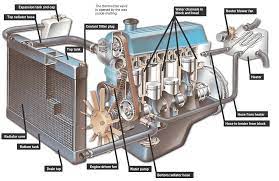If your vehicle’s cooling system has ever failed in the heat of summer, you are aware of how vital this component is for safe, comfortable driving. Your car’s cooling system regulates engine temperature and prevents overheating, which contributes to the overall health and longevity of your car. Consider this comprehensive guide to help you properly maintain and troubleshoot problems with the cooling system.
Cooling System Components
To best maintain your cooling system, you’ll first need to understand its basic components. First, the system contains coolant, also known as antifreeze, a liquid mixture of water and chemicals that moves throughout the engine to maintain a safe temperature. Most car manufacturers recommend changing the coolant every 30,000 miles to keep the cooling system in good working order.
The radiator, the heart of the cooling system, is responsible for dispersing heat from the water pump through the system, reducing the likelihood of overheating. The water pump does just what it sounds like—it pumps coolant through the engine to prevent overheating. A thermostat between the engine and radiator monitors the engine’s temperature, opening and closing to release coolant when needed. Finally, a fan switches on when the car’s coolant reaches a certain temperature.
All these cooling system components work together to circulate coolant, dissipate heat, and maintain optimal engine temperature.
Routine Cooling System Maintenance
Regular maintenance can help preserve the efficiency and reliability of your car’s cooling system. Here are some key maintenance tasks to perform:
- Coolant Flush and Replacement. As a rule, flush and replace your coolant every 30,000 miles or three to five years, whichever comes first. This can help prevent corrosion, maintain proper pH levels, and ensure optimal cooling performance.
- Inspect Hoses and Belts. Check for signs of wear, cracks, or leaks in hoses and belts. If you spot damage, replace those components promptly. If you can’t take the car to the mechanic immediately, you can usually drive for a few days, topping off the cooling system with water when it gets low.
- Radiator Cleaning. Over time, the radiator can accumulate debris, bugs, and dirt. Regularly clean the radiator fins to ensure proper airflow. You can use a soft-bristled brush to carefully remove small rocks, bugs, or other items clogging the radiator fins, then apply an engine-safe cleaner/degreaser. Finally, use a low-pressure hose to gently rinse the radiator. If the water still appears dirty, repeat the process a few more times.
- Water Pump Inspection. Examine the water pump for leaks or unusual noises. If you notice rust on the pump’s surface, you might have used a non-compatible coolant mixture or have a defective pressure cap that has let in air. Along with signs of wear, you may also notice small holes or corrosion in the metal, which usually means you’ll need a new water pump. Older model cars typically need a new water pump after 60,000 to 100,000 miles.
Troubleshooting Common Cooling System Issues
Even with routine maintenance, cooling system issues can arise. Some of the most common problems include the following:
- Overheating. This can be caused by multiple factors, including a faulty thermostat, water pump failure, or coolant leaks. A failing thermostat is the most common cause of overheating. To test your thermostat, turn on the car and let the engine warm up. Then, open the hood and find the upper and lower radiator hoses, checking their temperature with a temperature gun. If the car begins to overheat and either both or one of the radiator hoses are cold, you likely need to replace the thermostat.
- Coolant Leaks. Leaks can occur in various areas, including the radiator, water pump, hoses, or gaskets. Inspect for visible signs of leaks, such as a light-colored residue or puddles beneath the car or around the radiator cap. If a hose seems to leak near a clamp, tighten the clamp with a screwdriver. If an engine has too little coolant, it will run hot, damaging both fuel economy and performance. Over time, an overheating engine can cause long-term damage to the car.
- Radiator Fan Malfunction. A car will overheat if the cooling fan does not blow. Test the fan by running the engine and monitoring its operation. If the fan doesn’t engage or spins slowly, check the fan motor, relays, or temperature sensors. A mechanic can help you replace or repair a malfunctioning radiator fan.
- Coolant Contamination. Contaminated coolant can lead to cooling system problems. Look for signs of oil or debris in the coolant, which may indicate a leaking gasket or a failing component.
When to Seek Professional Help
While some cooling system issues can be resolved through preventative maintenance and troubleshooting, more complex problems may require professional assistance. If you are unsure or lack the necessary expertise to diagnose problems with your cooling system, it’s wise to consult a qualified mechanic. The sooner you address cooling system issues, the more you can save on costly repairs down the road. A well-maintained cooling system is key to keeping your engine cool, extending its lifespan, and maximizing your vehicle’s overall performance.
